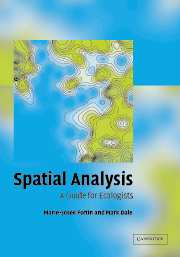Book contents
4 - Spatial partitioning of regions: patch and boundary
Published online by Cambridge University Press: 29 July 2009
Summary
Introduction
In order to understand ecological processes at multiple scales, ecological studies are often carried out over large regions. In doing so, most study areas include more than one ecological process that can act at different spatial and temporal scales (Dungan et al. 2002). In such cases, it is unlikely that the assumption of stationarity of process (i.e. the same mean, variance and isotropy; see Chapter 1) is true. To analyse ecological data from large regions in a meaningful way, it is recommended that the region be partitioned into smaller, more spatially homogeneous areas (i.e. patches), that are more likely to be governed by the same ecological process. Stratifying a region can also be useful for monitoring and managing resources. There are two main approaches to spatial partitioning:
grouping adjacent locations that have similar values of the variable(s) under study by generating spatial clusters (Figure 4.1), or
dividing areas, based on their degree of dissimilarity, by delineating boundaries (Figure 4.2).
In theory, the outcomes of these two types of approaches should provide the same partitioning. In practice, however, there can be more or less pronounced spatial mismatches between the two methods. This is because the majority of the partitioning methods are descriptive and somewhat subjective in their use and interpretation. In this chapter, we are going to present the spatial partitioning methods, both spatial clustering and boundary detection, which are most relevant to ecologists (Figure 4.3).
- Type
- Chapter
- Information
- Spatial AnalysisA Guide for Ecologists, pp. 174 - 211Publisher: Cambridge University PressPrint publication year: 2005



